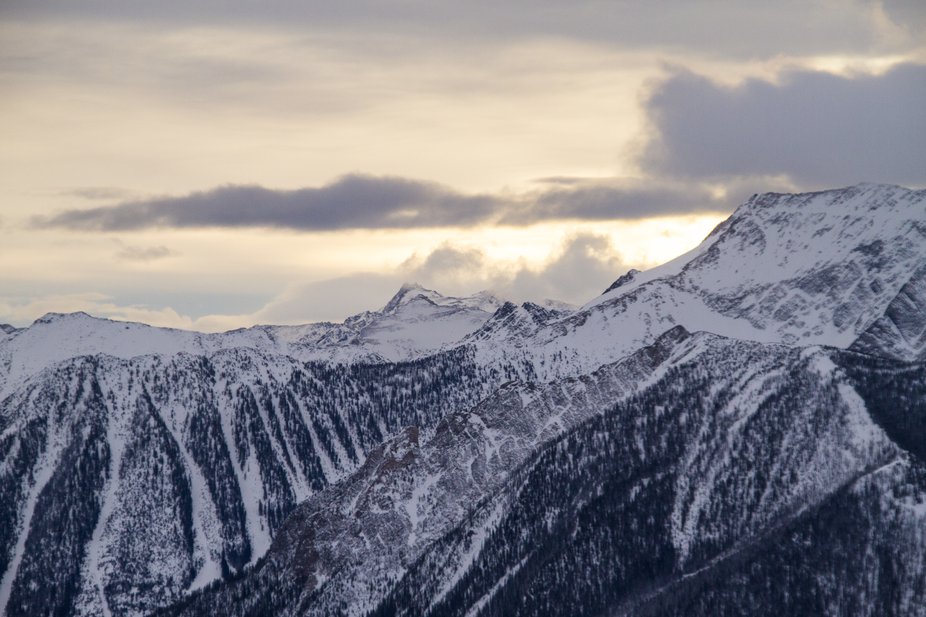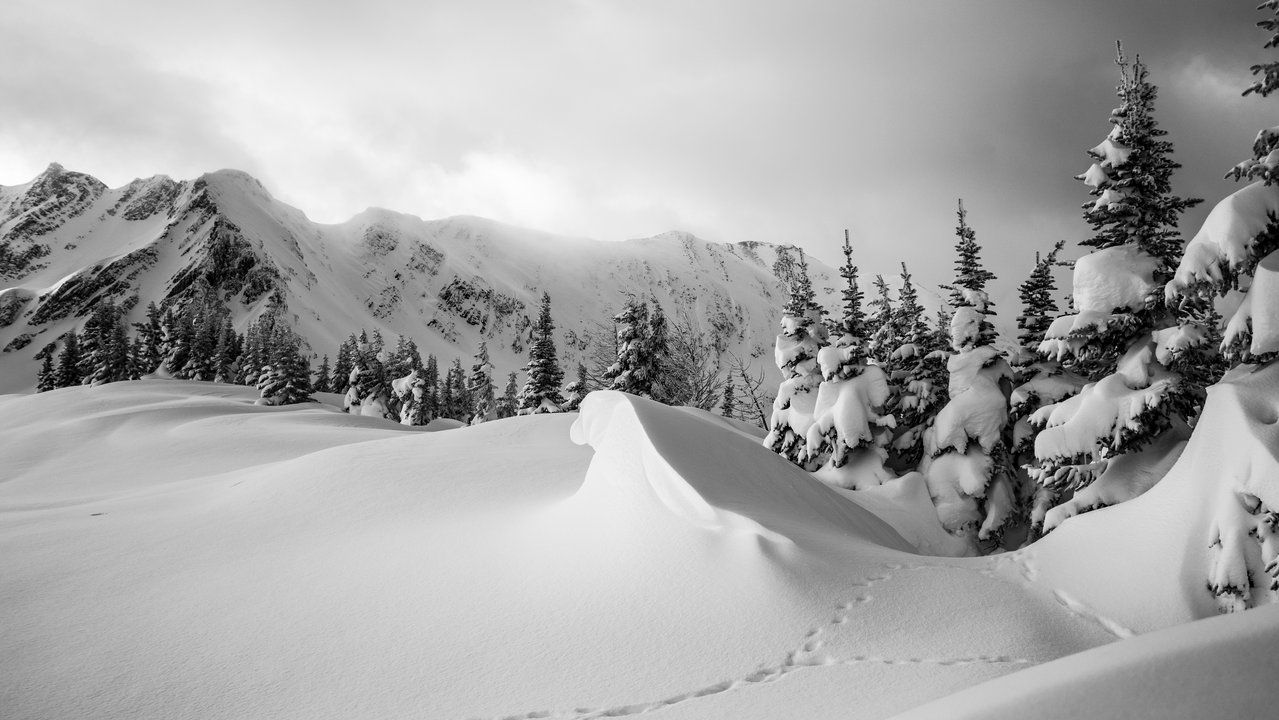The gusty east wind breaks just before dawn, and the clouds pop for a few moments just after. The peak is illuminated in golden hour light for a brief glimpse, but no one really notices. Usually, by now there’d be a few groups working their way up the skin track, breaking trail and appreciating the beauty of the rugged summit block glowing gold as the sun rises. But today there is no skin track, where it usually meanders up the ridge there are only fresh wind drifts, sculpted into fecund arcs by the wind. And instead of backcountry skiers reaching for their phones as the mountains sing in the dawn light, there’s just a cow moose, waiting for her calf to wake so they can wander down the brushy valley floor.
If you were on that ridgeline, you could have heard the faint explosions coming from the ski resort as patrol runs their morning routes. You could have felt the concussions as much as you heard them, deep echos through the fog that socked back in almost immediately. But today there are no backcountry skiers to pause and comment on the bombing as they toil upward.
The faces off either side of the ridge look like some kind of manufactured paradise for skiers. The south side sweeps off smoothly in a series of mellow bowls punctuated by trees. A few thousand feet of fun, playful fall lines and mini-pillows. The north-facing aspect is steeper, with sections jutting almost vertical from the valley below. But the cliffs are broken with line after steep line, big couloirs, and chutes that plummet constantly downwards. And below them are complicated little cliff zones, spines, and airs with steep, deep landings. Usually, the parking lot would be filling up at first light, skiers would be groggily spilling from their cars, slipping into boots, and checking beacons as they prepare to climb the ridge. Today there’s just one car though, and they’ll break trail through the 18 or so inches of new snow for an hour, just reaching the first real pitch of the track before they realize their folly and turn back to the car, head off in search of mimosas and pastries.
The ridge has a few full-time residents, the chickadees and ravens spend their lives up here, nesting in burled old pines and surfing the thermals that float up from the valley. The marmots are all asleep under feet of snow, cozy in their alcoves, but a pine marten is already out and about, dancing through the new snow, cavorting on the cornices last night’s winds built. He’s more aware of the snowpack than most skiers, he spends his days diving in and out of it, and he knows its layers. Today the top is firm, nearly impenetrable, burnished hard by the night’s winds. But underneath, maybe three feet below, it’s soft and easy for him to travel. He’s wormed along under that crust, tunneling easy through the weak layer that suspends the wind slab, hunting for voles and mice. He knows there’s an icy crust a few inches below that softer layer, and then stacks of inconsistent storm cycles down the ground. The martin doesn’t know much about skiing, but he does remember that last time the snowpack felt like this, an errant mountain goat kicked some rocks onto a cornice and the whole valley settled a little as a thousand feet wide, and five feet deep of snow decided to follow gravity’s decree. That drainage is still littered with the trees that avalanche took down, a foot or more in diameter, like giant shattered pick-up sticks jamming the creekbed.

Today the mountains are fragile. They’re quiet, not with peace but with pent-up danger. Like a partner who won’t tell you what’s wrong, and instead leaves you to stew in a silent, angry house, they’re just waiting to explode. That danger always lurks on this ridgeline, but usually, it’s not so immediate, not the result of such drastic weather patterns. And usually, it doesn’t matter how loudly the mountains are screaming “Don’t touch me today!” some wily humans will push up to the summit, talk loudly about their plans to minimize risk, and plunder her goods back down to their cars. The locals are prepared for it, banking on it. The moose know where to bed down far from the skin track, the martin knows to bounce to safety when he hears the shuffle of skins, and the ravens are ready to pick at any crumbs the skiers might drop as they transition.
But today no one climbs the ridge. No skiers swing through switchbacks, trying to listen to the warnings the mountains drop. Maybe it’s because today they’re so loud that they can hear them from town, loaded peaks warning backcountry travelers to stay inbounds, make peace with the lines, and tracked out terrain that ski patrol can make safe for them. The mountains are calling, but it’s a warning, “Stay Home!” “Drink hot chocolate, ski the resort and let us heal!”
And today, somehow, every skier in the valley hears their call and listens to it. No one climbs that ridge, no one rips their skins and pivots their planks into the fall line for the first time. No one drops into those first few turns that decide whether this is going to be your best day skiing, or your last, or both. The runs off that ridge lie perfect without tracks, a ski movie set without actors or crew. Tomorrow a few groups will climb to the summit, dart down cautiously, scurrying from pocket of relative safety to pocket of relative safety before they breathe deep as they exit to the car. Next week all the prime lines will be tracked out, powder slashes in the deep pockets as skiers whoop and holler. But for now, the ridge is quiet. No one will die on it today. No helicopter will circle, dropping tired-eyed men and women onto the debris field. No one will have to make those final observations, no note in the evening email report, no one will leave a car in the parking lot with no owner to drive it home. Today at least, the mountains will rest.
This has been a hard avalanche season. I don’t hold any judgment or second-guessing or insight, just a profound sorrow. Hug your people, do your best to come home to them.


Comments